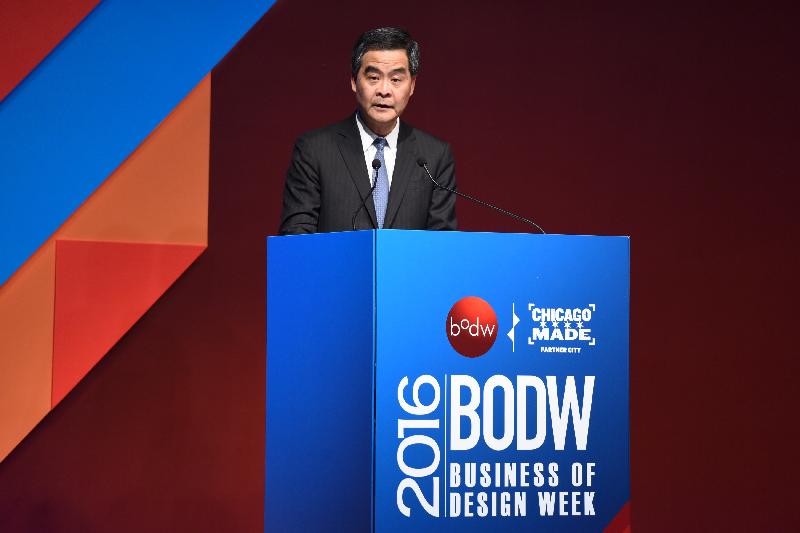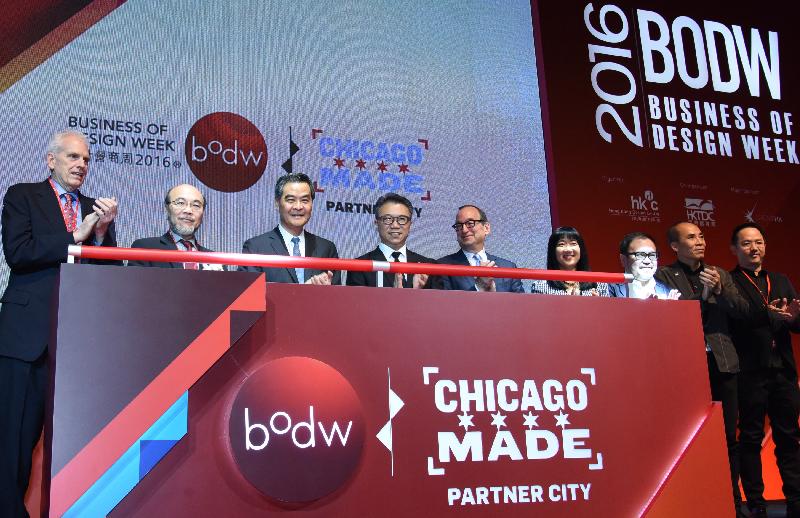Speech by CE at Business of Design Week 2016 opening ceremony (English only) (with photos/video)


Following is the speech delivered by the Chief Executive, Mr C Y Leung, at the opening ceremony of Business of Design Week 2016 at the Hong Kong Convention and Exhibition Centre today (December 1):
Eric (Chairman of the Board of Directors of the Hong Kong Design Centre, Professor Eric Yim), Margaret (Executive Director of the Hong Kong Trade Development Council, Ms Margaret Fong), Deputy Mayor Koch (Deputy Mayor of Chicago, Mr Steve Koch), Consul General (Consul General of the United States to Hong Kong and Macau, Mr Kurt Tong), distinguished guests, ladies and gentlemen,
Good morning. It is a great pleasure to join you for the opening ceremony of the 2016 Business of Design Week.
This is, I am pleased to note, the 15th anniversary of BODW. The event has come a long way from its September 2002 launch. It was more of a local gathering in the beginning. Today, BODW is the largest event of its kind in Asia, attracting more than 100 000 people from a great variety of industries and professions: designers, artists, architects, entrepreneurs, communications specialists, policymakers, academics, students and more.
Which begs the question: What exactly is design? I lean towards the school that says everything is designed - though not always as well as we might want. Understandably so. As American designer Paul Rand once said, "Design is so simple. That's why it's so complicated."
That's certainly a big reason why you are here at BODW. To see what works, and why. To experience good design. To learn from the world's top designers and from each other. To be inspired by other people's work, and words.
With over 70 high-profile speakers from all over the world here at BODW, and networking opportunities everywhere, the inspiration is sure to flow fast and free.
BODW promises that, in part, through its annual partner programme. Partnering each year with a different country, or city, BODW ensures a fresh perspective in sharing experience, encouraging collaboration, inspiring innovation, and creating value for all. This year, Chicago finds a welcome spotlight, as BODW's Partner City.
I was in Chicago in June last year, for the Hong Kong Trade Development Council's "Think Asia, Think Hong Kong" business event, one of the largest Hong Kong promotions ever in the United States.
Many know Chicago as a major financial and business centre. But Chicago is equally renowned for its bold architecture, a city blessed with landmark buildings, museums, innovative parks, public art, and the newest city stunner: the Chicago Riverwalk. I am told that the last stage of the Riverwalk just opened in October.
So partnering with Chicago makes perfect sense. Our two cities have a good deal in common. Hong Kong is a city of skyscrapers as well, and we, too, have a spectacular harbourfront. Like Chicago, we have moved on from a manufacturing economy to a services economy - finance, commerce, logistics, innovation, professional services and other high value-added activities.
And our two cities are forging new partnerships. Last week, I met with President Zimmer of the University of Chicago, who was here for the naming ceremony of the University of Chicago Center in Hong Kong. The Center will house the Asian campus for the Executive MBA programme of the Booth School of Business. The Center will, as well, bring together academics, students and researchers from Chicago, Hong Kong and the Mainland of China.
Earlier in June, the Massachusetts Institute of Technology set up an Innovation Node in Hong Kong, its first outside the United States. In explaining why the MIT chose Hong Kong as its base, the MIT President said, and I quote, "By bringing MIT to Hong Kong and Hong Kong to MIT, the Innovation Node will deepen MIT's activities in Hong Kong and, through Hong Kong, in the entire Pearl River Delta region." The Faculty Director of the Innovation Node, Professor Charles Sodini, had this to say, and I quote, "Manufacturers in Shenzhen have mastered the ability to take a prototype device to unit quantities of hundreds overnight ... This unparalleled speed of small quantity manufacturing is unique to Shenzhen." By the way, Shenzhen is a city on the Mainland of China that is a 40 minutes' drive from here.
These are examples of how we turn the "one country, two systems" arrangement to our advantage, and how we share the advantage with our international partners. We benefit in many ways from the Mainland's far-reaching reforms and rapid economic development, while at the same time maintain close international connections. In short, we are a global "super-connector", connecting you to the rest of China with a world of suppliers, markets, talents and creativity.
BODW is a working illustration of Hong Kong's success in bringing together creative industries, and the professionals who bring them to bright life. Indeed, cultural and creative industries contribute about US$14 billion to our GDP, while employing more than 210 000 people.
We are determined to boost our creative industries and grow Hong Kong into a creative hub. It is only through innovative design, and technology, that we can ensure Hong Kong's place in tomorrow's global economy.
And we must embrace as broad a remit as possible. More than creating a product, design is also about innovative production processes, imaginative use of city space to improve quality of living, and integration of culture and recreation into everyday lives of the Hong Kong people.
In that, and more, there is much we can learn from Chicago, beginning this week at BODW. I am confident that "ChicagoMade" will inspire a Hong Kong-designed future.
My thanks to the Hong Kong Design Centre for organising the Business of Design Week. My thanks, as well, to all of you taking part - designers, innovators and creators.
I wish you a good dose of inspiration at the Business of Design Week, and a rewarding year ahead.
Thank you.
Thursday, December 1, 2016